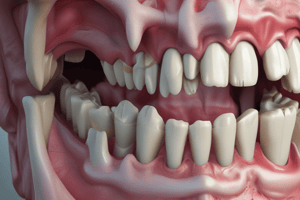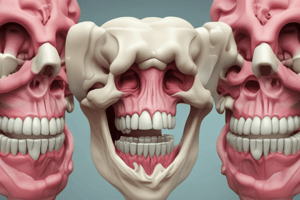Podcast
Questions and Answers
What is a characteristic of the buccal roots of the maxillary second molar?
What is a characteristic of the buccal roots of the maxillary second molar?
- They are longer than the palatal root
- They are parallel and inclined distally more than the maxillary first molar (correct)
- They are wider mesiodistally than the first molar
- They are 11mm in length
What is the length of the buccal roots of the maxillary second molar?
What is the length of the buccal roots of the maxillary second molar?
- 12mm
- 11mm (correct)
- 10.5mm
- 10mm
What can be said about the fifth cusp in the maxillary second molar?
What can be said about the fifth cusp in the maxillary second molar?
- It is smaller than in the maxillary first molar
- It is absent (correct)
- It is larger than in the maxillary first molar
- It is more prominent than the distolingual cusp
How does the length of the palatal root of the maxillary second molar compare to the buccal roots?
How does the length of the palatal root of the maxillary second molar compare to the buccal roots?
Where is the apex of the lingual root of the maxillary second molar located?
Where is the apex of the lingual root of the maxillary second molar located?
Flashcards are hidden until you start studying
Study Notes
Buccal Aspect
- The crown is shorter and narrower mesiodistally compared to the first molar.
- The distobuccal cusp is smaller in size.
- The buccal roots are 1mm shorter than the buccal roots of the first molar (11mm).
- The buccal roots are parallel and inclined distally more than the maxillary first molar.
Lingual Aspect
- The distolingual cusp is smaller than in the maxillary first molar.
- The fifth cusp is absent.
- The apex of the lingual root is aligned with the distolingual cusp tip.
Studying That Suits You
Use AI to generate personalized quizzes and flashcards to suit your learning preferences.




